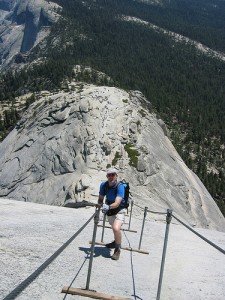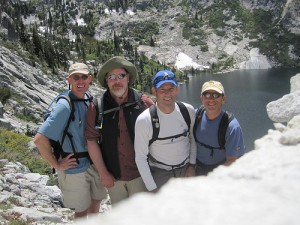As a native Californian, I’ve lived through a fair number of earthquakes, including the 1989 Loma Prieta that literally knocked me on my ass in my old condo in San Francisco. As the 20th anniversary of that quake approaches, I got to thinking about that event and what it means to live on terra infirma.
For anyone who hasn’t had the experience, it’s hard to describe what it’s like to have the ground literally go to pieces. When the rumbling starts, your reptilian brain tries in vain to figure out what’s going on. Then it slowly dawns on you – oh yeah, an earthquake! But by that time (if you’re lucky) the quake has passed.
Sometimes, however, the rumbling continues. That probably means a bigger one. The ground or whatever you’re in that is perched on the ground is now moving. Side to side. Up and down. The noise is considerable, a combination of the deep basso profundo of the tectonic plates rubbing up against each other, the alto of windows rattling and perhaps even the soprano of plates shattering. In a really sizeable one – anything over 6.0 on the Richter scale – you frantically seek cover (under a solid table is a good place) or plot a mad dash for open ground. Then, eventually, it all goes quiet.
If you experience enough of them you develop an inner seismograph, especially with the aftershocks that generally follow a major quake. Mine has become remarkably accurate. A temblor will roll through for a few seconds, barely rattling the windows and feeling as though someone jumped on the sofa. “High threes,” I’ll say to my wife as we look up from our books. “Maybe 4.1 or 4.2.” We’ll read about it in the paper the next day: a 4.0 quake struck at 9.13 pm with an epicenter in Napa.
The Richter scale is logarithmic, meaning a 5.0 quake is 10 times bigger than a 4.0 quake, and a 6.0 one is 100 times more massive. So… the 1989 Loma Prieta measured 7.1 on Charles Richter’s eponymous ruler. You do the math.
I was working at home on October 17, 1989, and eagerly anticipating watching the 3rd game of the World Series, the so-called Bay Bridge Series between my then-beloved Oakland Athletics and the San Francisco Giants. (As baseball fans will recall, the A’s had convincingly won the first two games behind the strong pitching of Dave Stewart and Mike Moore. Because of the ten day delay that followed the earthquake, both pitchers were able to pitch again when play resumed, repeating their victories for a four game sweep.)
Fortunately for me, I was living in a building on Clay Street, near the top of Pacific Heights, meaning I was on bedrock. Ironically, the building was of the “Marina” style, which is a type of 1920s wooden construction with three residential stories over a ground level parking garage. This was the architectural layout that doomed many identical structures in the Marina district, since the parking area didn’t have diagonally-braced walls. But those buildings were built on the Marina’s landfill, not bedrock, so when the quake struck their foundations wiggled and sagged in the sandy liquefaction.
Bedrock or not, it was a terrifying experience. I remember walking through my dining room and the floor literally rising up and sending me flying. I landed on the hardwood floor, clinging for a hand-hold as the apartment pitched and heaved. Recordings show the quake lasted all of 15 seconds but it felt like at least double that duration, maybe more.
The weird thing about riding out a major quake in a solid neighborhood is that you have no idea of the extent of the damage. Power was immediately lost so I had to dig out a battery-operated radio to get any news whatsoever. (I’m embarrassed to say that, once I’d survived the quake intact, with no real damage to my building, my initial reaction was annoyance that I wouldn’t be able to watch the baseball game on TV. I naively assumed the game wouldn’t be interrupted.) After walking into the street and connecting with similarly dazed neighbors, we drifted back to our units to resume our lives. Completely oblivious to the utter devastation in other parts of San Francisco and the greater Bay Area.
Local radio reports were similarly hampered by the loss of power, so I got the first inkling of the scale of disaster with a phone call from my parents – from England! They’d seen TV news footage and my mother, who is known for her hyperbole and melodrama, painted a shocking picture. San Francisco was in flames! The Bay Bridge had collapsed! Scores of people had been crushed to death beneath collapsed freeways! It was only later that I would learn this was all, more or less, true.
As news of the destruction started to trickle in, neighbors of mine sought each other out. We collectively worried about missing spouses and significant others — lots of workers were stuck in the Financial District and, remember, this was back before many people had cell phones. As they straggled the several miles home on foot (I believe the SF Muni, which barely operated in those days in normal circumstances, was totally out of commission), the mood lightened. We’d survived and now the question was, what about the rest of the city?
This human coming together, as I recall, was the feel-good story of the Loma Prieta aftermath. Neighbors who may have only exchanged pleasantries before the quake suddenly became much closer. There was no TV to distract us so as the daylight faded we lit candles and uncorked wine and shared stories. What else was there to do, really? To be completely honest, the succeeding several days were some of the best in my life. People really came together, throwing BBQ parties (why waste all those thawing steaks?) and helping out total strangers in need. Nobody could go to work so it was like a holiday, but with a community purpose. Several of my good friends lived in the Marina District and their buildings had been condemned. In cases of less than total destruction, the authorities gave residents 15 minutes to go into their homes and remove belongings for the last time. The firefighters were worried an aftershock might bring down the structure entirely. (My friend Monique was not so lucky: her building was completely destroyed. She was at the baseball game and literally escaped with the clothes on her back.)
My friends Jesse and Barbara had to evacuate their apartment, so together with our buddy Chris, I rented a U-Haul truck so we could drive to their Marina apartment and remove enough of their belongings in the allotted 15 minutes. The only problem – the fire and police departments had cordoned off the neighborhood and wouldn’t let any vehicles in. What to do? Luckily, we got talking to an NBC reporter who wanted to report on our situation. So we struck a deal – he could film and interview us during our rush exodus if, with his credentials and camera crew, he helped us pose as a press vehicle to make it past the checkpoint. It worked. Safely past the police sentry, we drove over severely cracked pavement, parked in front of the tilting building and rushed upstairs to start unloading. Jesse started carrying more delicate items (photo albums, artwork, etc.) downstairs while I literally tossed bedding and clothes out the window onto the sidewalk. Luckily, the fire marshall had a soft heart and didn’t hold us precisely to 15 minutes. We had time to load enough of significance and even conduct our NBC News interview.
I’ll never forget Jesse’s mother arriving midway through the process, dressed as if for the opera and carrying a huge bag of gourmet food which she commenced to pass around. We stared at her in disbelief as we ran frantically to and fro trying to beat the looming time limit. As a non-resident, how in the world had she got in? Simple – she’d explained the situation to a sympathetic police officer who then proceeded to escort her taxi through the checkpoint on his motorcycle. So typically San Franciscan.
With Jesse and Barbara safely evacuated and sleeping in my living room, life took on an odd schizophrenia that probably characterizes many disasters. On the one hand, you are shocked by the devastation and saddened for those who have suffered – or even perished. But on the other hand, you’re experiencing life at its most elemental and fulfilling, so it’s hard not to take some perverse pleasure in that. After the power came back on (I think it was day two or three), I retrieved an old soldering iron and in the evenings started assembling an aircraft intercom kit I’d been meaning to put together (I was flying more actively back then.) Soothing, repetitive, tactile work, kind of like knitting. During the day, I helped friends move into temporary housing and otherwise volunteered doing relief work. Meanwhile, our little city was the focus of worldwide attention and sympathy.
But don’t get me wrong – I have no desire for a repeat of that post-apocalyptic experience. I suppose it was the 1994 Northridge earthquake that really got to me. I wasn’t there for the main temblor but I immediately flew down to Burbank after learning how much damage had been wrought on both my parents’ and my sister’s residences in the San Fernando Valley. Upon visiting my parents’ place in Sherman Oaks, actually my sister’s old condo which they were using as a pied-à-terre while they contemplated moving back from England, I was surprised they were still alive. The place looked like a tornado had struck, with furniture and books and large appliances (television, refrigerator) scattered around like matchsticks. A massive bookcase had come down on my mother’s side of the bed, which was also skewed at a bizarre angle. If my mother hadn’t been in the bathroom when the quake struck (it was before dawn), the bookcase undoubtedly would have crushed her.
I remember standing in a hardware store in Chatsworth (where my sister lived) when the first of several aftershocks struck. Maybe around 5 on the Richter scale but with the plate glass windows rattling and everyone’s nerves already frayed to the breaking point, I was not a happy camper. Then another similar aftershock rolled through maybe five minutes later as I was lined up at the cash register. That one really pissed me off; I remember swearing out loud, loudly. I wanted to buy the spare part for my sister’s house (what was it, a toilet valve? I forget) but my instincts were to drop everything and run outside. It was like being subjected to a geological form of waterboarding. A younger, more callow version of myself used to tell people that I “enjoyed” earthquakes, I suppose as some sort of native Californian badge of honor, but no more.
The reality is there will be another major quake in the years to come. Maybe even a “Big One” like the 1906 San Francisco earthquake – and we all have read how nasty that was. Living with this kind of uncertainty is bizarre. We can’t really do anything about it, except prepare disaster kits (we have them in both of our vehicles, as well as the house) and an emergency plan. Earthquakes are unique among natural disasters in that there is no warning possible.
As with other unpleasant things, people tend towards a state of denial about earthquakes. I remember, in the wake of the Loma Prieta quake, homeowners in the Marina District putting their properties up for sale with handmade cardboard signs at bargain-basement prices. But within a few years people drifted back and “forgot” the dangers of living on quicksand. Today it’s one of the most desirable and expensive neighborhoods in San Francisco. But you’d never catch me – or Jesse and Barbara – living there.
Two decades have gone by – it’s hard to fathom. So much has occurred since then, but in some ways it seems like yesterday. I suppose in geologic terms it was a millisecond ago. Like the fault lines themselves, that cuts both ways. We’re only here on this blue marble of a planet for a brief spell, but the aggregate of moments we do have often give the illusion of permanence. So: here’s to making the most of what we have while we’re here. And, whenever possible, to sinking our foundations into bedrock!


